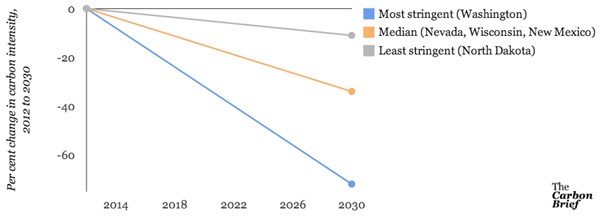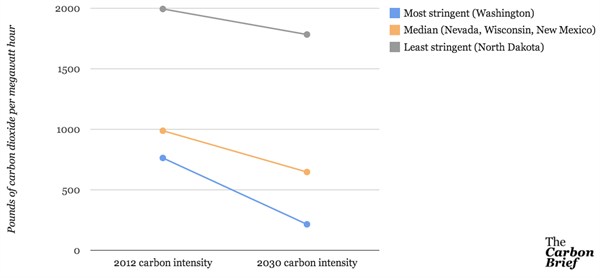Mat Hope
05.06.2014 | 3:55pmPresident Obama’s plan to cut US emissions was launched with great fanfare earlier this week. Analysts are now scratching their heads trying to work out the details. Here are three of the plan’s key components.
Carbon intensity
Monday’s announcement led to a spate of headlines declaring the plan would cut power plant emissions by 30 per cent by 2030. But while that’s the potential outcome of the plan, it’s not the goal.
The EPA is not telling states how much their power sectors can emit. It is telling them how much they can emit per unit of power generated. The EPA calls this a “pollution-to-power ratio”, but it’s more often called carbon intensity.
Based on expected demand for power, it thinks these limits will add up to a 30 per cent power sector emissions cut compared to 2005. But its expectations of demand could be wrong. So emissions could go up even if states meet their carbon intensity targets.
For instance, the EPA’s own modelling suggests California could reduce its carbon intensity by 23 per cent even if its overall power sector emissions grow 14 per cent.
The EPA is also calculating carbon intensity in an unusual way, making it harder to decipher the plan’s overall effect on emissions. In order to give states flexibility to meet the goals, the EPA will factor renewable energy and energy efficiency measures into its carbon intensity calculations.
But while ramping up renewable energy capacity could reduce the power sector’s carbon intensity it may not have an impact on emissions. In contrast, implementing energy efficiency measures could reduce demand – and therefore emissions – but won’t change the power sector’s carbon intensity.
Such complications mean industry and analysts alike are still unsure how the carbon pollution plan will affect the power sector, according to consultants Bloomberg New Energy Finance.
Pragmatism
While the media lauded the plan as bold, it’s principally a pragmatic move.
The EPA has worked out what each state’s targets should be, based on their ability to act.
For instance, some states may be better able to ramp up renewables such as solar and wind power because of amenable weather. Others states may have significant shale gas reserves, so could be better placed to reduce emissions that way.
So the EPA has decided some states can make much more stringent cuts than others. The graph below shows how steeply the state with the most stringent target, Washington, has to curb its carbon intensity compared to states with less demanding goals:

Source: Data from Bloomberg New Energy Finance, graph by Carbon Brief
This chart shows what that means in terms of power sector carbon intensity. It shows that in some cases states with the most polluting power sectors are being asked to make less effort to clean up.

Source: Data from Bloomberg New Energy Finance, graph by Carbon Brief
A number of states are already on track to hit the EPA’s goals. Analysis by the ENDS Report shows Iowa already gets 25 per cent of its electricity from renewables, but the agency’s calculations set it a target of 18 per cent. Others are already hitting the EPA’s target of improving energy efficiency by 1.5 per cent.
Flexibility
The EPA suggests a number of ways states could meet their goals, but says it’s ultimately up to them.
It outlines four effective ways states could reduce emissions, which it describes as the “building blocks” of each state’s emissions framework:
- Curb existing fossil fuel plant carbon intensity by upgrading turbines or adding expensive carbon capture and storage technology, for example.
- Increasing the amount of power from existing gas plants, in place of coal.
- Ramp up zero carbon generation, such as wind, solar, and nuclear power.
- Improve consumer energy efficiency, through measures like better building standards or smart grids.
These are only suggestions, however. The agency says states could also cut emissions through carbon trading or improving the efficiency of their transmission grids. Whichever way states choose to curb power sector emissions, the EPA has pledged not to interfere.
By basing the plan on what it considers to be easy to implement measures, the EPA has shown a taste for pragmatism. Given the obstacles the President has faced to get this far – and those he’s yet to leap – that strategy may prove to be prudent.

